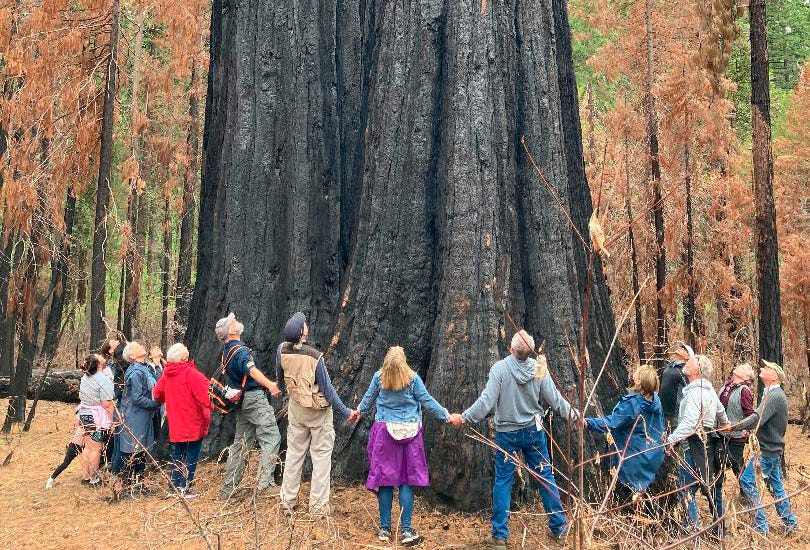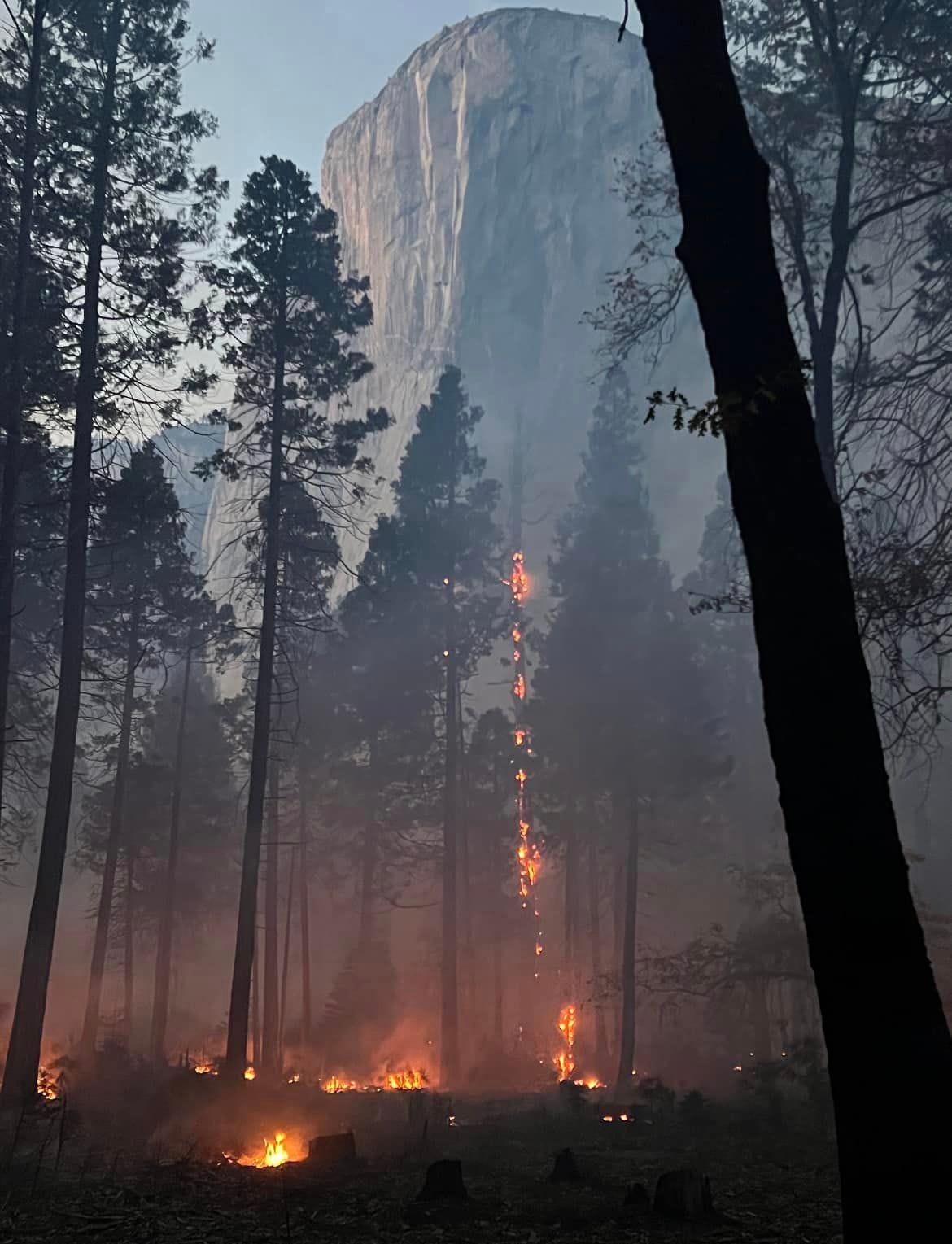The Orphans 'no longer stand alone'
State Parks confirms a pair of giant sequoias were not killed
Volume 2, Number 25 - Thursday, Nov. 2, 2023
Published twice a week, on Monday and Thursday

Perspective
THREE WEEKS AGO I reported HERE that there was good news about the giant sequoia trees known as “The Orphans” in Calaveras Big Trees State Park. Yesterday, the California State Parks issued a news release making the information official.
‘The Orphans’ at Calaveras Big Trees State Park Are Alive and No Longer Stand Alone” was the headline for the release from Amber Sprock, a spokesperson for the park.
Here’s what she said:
The sequoias were damaged during a prescribed burn in the park’s North Grove area last fall. Several scientists visited The Orphans on Thursday, October 5, and observed that they are alive and thousands of giant sequoia seedlings now surround them.
“Standing beneath these magnificent trees and seeing the carpet of baby seedlings is incredible,” said California State Parks Central Valley District Superintendent Danielle Gerhart. “Sequoia regeneration is one key forest management goal in Calaveras Big Trees State Park, and witnessing the results of the burn program through this new growth shows the importance of fire in the ecosystem. State Parks will continue to work to protect and preserve this land using many different tools and the latest science to manage the resources in the park.”
One of the scientists who visited the North Grove is Kristen Shive, assistant cooperative extension forest and fuels specialist at the University of California, Berkeley. “It was also heartening to see that The Orphans have survived and that there are so many seedlings at their base,” said Shive.
Out of these young seedlings currently battling to survive, only a few will become the next generation of giants. The Orphans and the new seedlings demonstrate giant sequoia resilience, fire dependence and adaptation. To protect the future of these seedlings and the North Grove, the public can help by remaining on the trail to avoid trampling the new growth.
Prescribed fire is an important forest management tool that returns fire to the ecosystem and reduces the risk of catastrophic wildfires. Giant sequoias cannot naturally reproduce in large numbers without fire. The heat from fire opens cones and helps release seeds. Fire kills competing trees and other plants. This mortality opens the forest, creating gaps in the forest canopy and allowing sunlight to reach the seedlings on the forest floor. Fire also returns nutrients to the soil and creates a mineral soil seedbed, which giant sequoias require to germinate.
In spring 2023, State Parks identified that The Orphans, named by early California immigrants, had suffered significant scorch from heat during the 2022 prescribed burn.
“Sometimes there are minimal losses of ancient trees even in a restorative prescribed fire,” said Shive. “Giant sequoias are not museum pieces, and some mortality is part of this living, dynamic ecosystem. But the potential for minimal losses in prescribed fire is far preferable to the thousands of ancient trees that were killed in 2020 and 2021, when fuel-loaded forests burned in severe wildfires. It’s great to see the park relying on the best available science to protect these incredible trees.”
Good news, indeed, and in the “news” section below, you’ll find links to other coverage.
Wildfire, water & weather update
Rain is expected by Monday, with temperatures dropping at Calaveras Big Trees State Park. At Yosemite National Park, there may be rain and snow at higher elevations from the same storm, but precipitation may not persist south of there. The best Sierra Nevada weather forecasts are at NWS Hanford, HERE, and NWS Sacramento, HERE. As usual at this time of year, Santa Ana winds drive fires in Southern California.
Wildfire update: As weather and other conditions allow, prescribed burning continues at many locations in the Sierra Nevada. If you check out the WatchDuty map HERE you’ll see a string of green flame icons where prescribed burning is underway.
Two days ago Calaveras Big Trees State Park reported that the long-awaited South Grove prescribed burn has been postponed due to recent wet weather. The crews will reassess it this week for the new earliest burn date.

The future of this newsletter
I appreciate the response I’ve had from a number of readers about the future of this newsletter and my Giant Sequoia News efforts since writing about this on Thursday. If you missed that, you can read it HERE. If there is sufficient support, I would like to reshape this effort into a nonprofit news organization.
As I noted, there was a time when newspapers up and down the state had reporters who did a fine job covering giant sequoia and related Sierra Nevada issues. Those days are gone forever.
With more support, I think Giant Sequoia News could grow to fill the resultant void.
If you have ideas, please reach out.
Did you know you can comment here?
It’s easy to comment on items in this newsletter. Just scroll down, and you’ll find a comment box. You’re invited to join the conversation!
Giant sequoias in the news
• You can read the Los Angeles Times article about The Orphans HERE.
• And a Fox News report about The Orphans HERE. (There are many others, but they’re pretty much alike.
• “Climate change is turning swaths of California’s mountains into ‘zombie forests’” is the headline for a piece in the Los Angeles Times this morning. You can read it HERE. And an excerpt:
When these forests burn in high-severity wildfires — or are wiped out by drought, disease or pests — they will likely be replaced by other types of trees and brush, the scientists said. That could dramatically slash how much carbon the region can store; provide a habitat for invasive species; and displace plants and animals that call the forests home.
• TV station KSBY in San Luis Obispo has a piece HERE titled “Fire, other ravages jeopardize California’s prized forests.” Although the focus is on Eldorado National Forest (not home to giant sequoias), the story could be set just about anywhere in the Sierra Nevada. An excerpt:
In the U.S. West, a century of fire suppression, logging of large fire-resistant trees, and other practices allowed undergrowth to choke forests. Drought has killed millions of conifers or made them susceptible to disease and pests. And a changing climate has brought more intense fires.
And another:
Despite mild wildfire seasons last year and this year, California saw 12 of its largest 20 wildfires in the previous five years. Record rain and snowfall this year that mostly ended a three-year drought could lead to explosive growth of fire fuels.
California has lost more than 1,760 square miles (4,560 square kilometers) — nearly 7% — of its tree cover since 1985, a recent study found.
A study of the southern Sierra Nevada — home to Yosemite, Sequoia and Kings Canyon national parks — found nearly a third of conifer forest had transitioned to other vegetation because of fire, drought or bark beetles in the past decade.
“We're losing them at a rate ... we can’t sustain,” said Brandon Collins, co-author of that report and adjunct forestry professor at the University of California, Berkeley.
Not everyone believes forest is disappearing. Some environmentalists, like Chad Hanson of the John Muir Project sponsored by the nonprofit Earth Island Institute, believe there's a “myth of catastrophic wildfire” to support logging efforts.
Thanks for reading!



